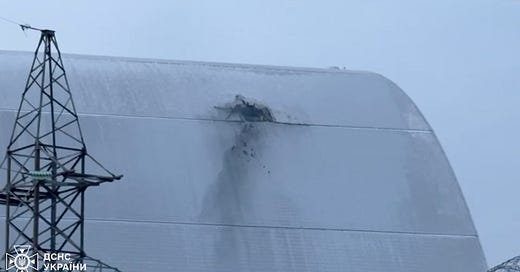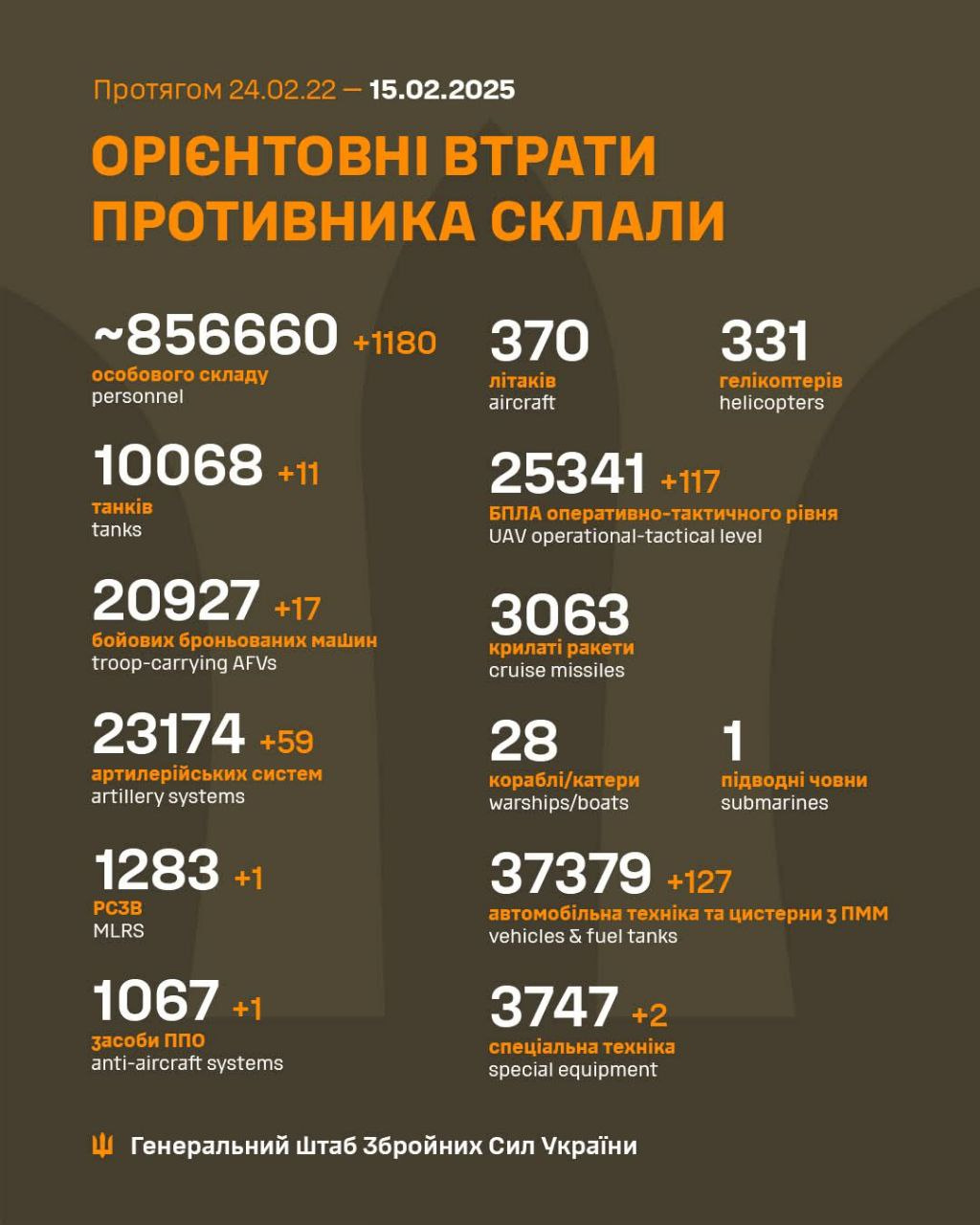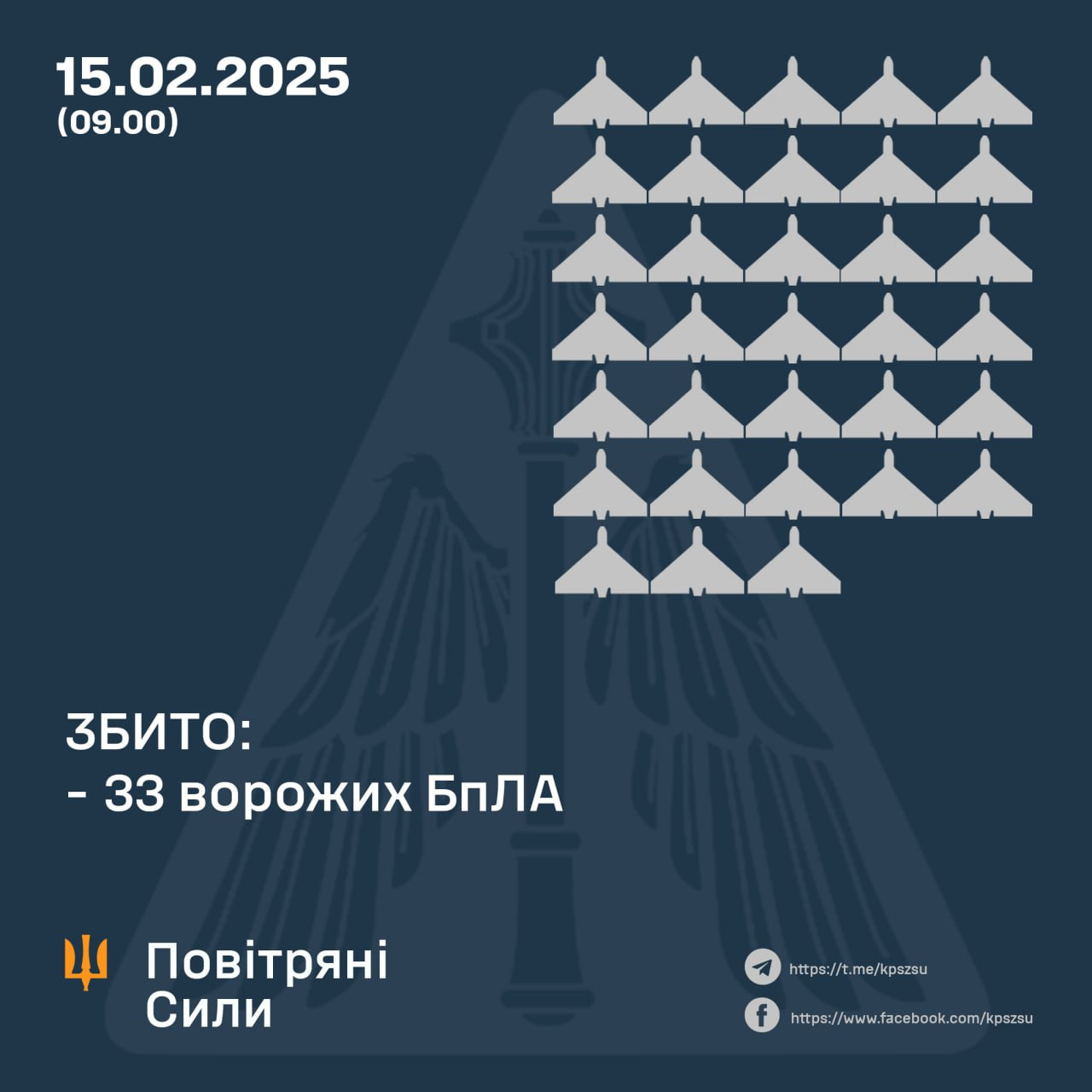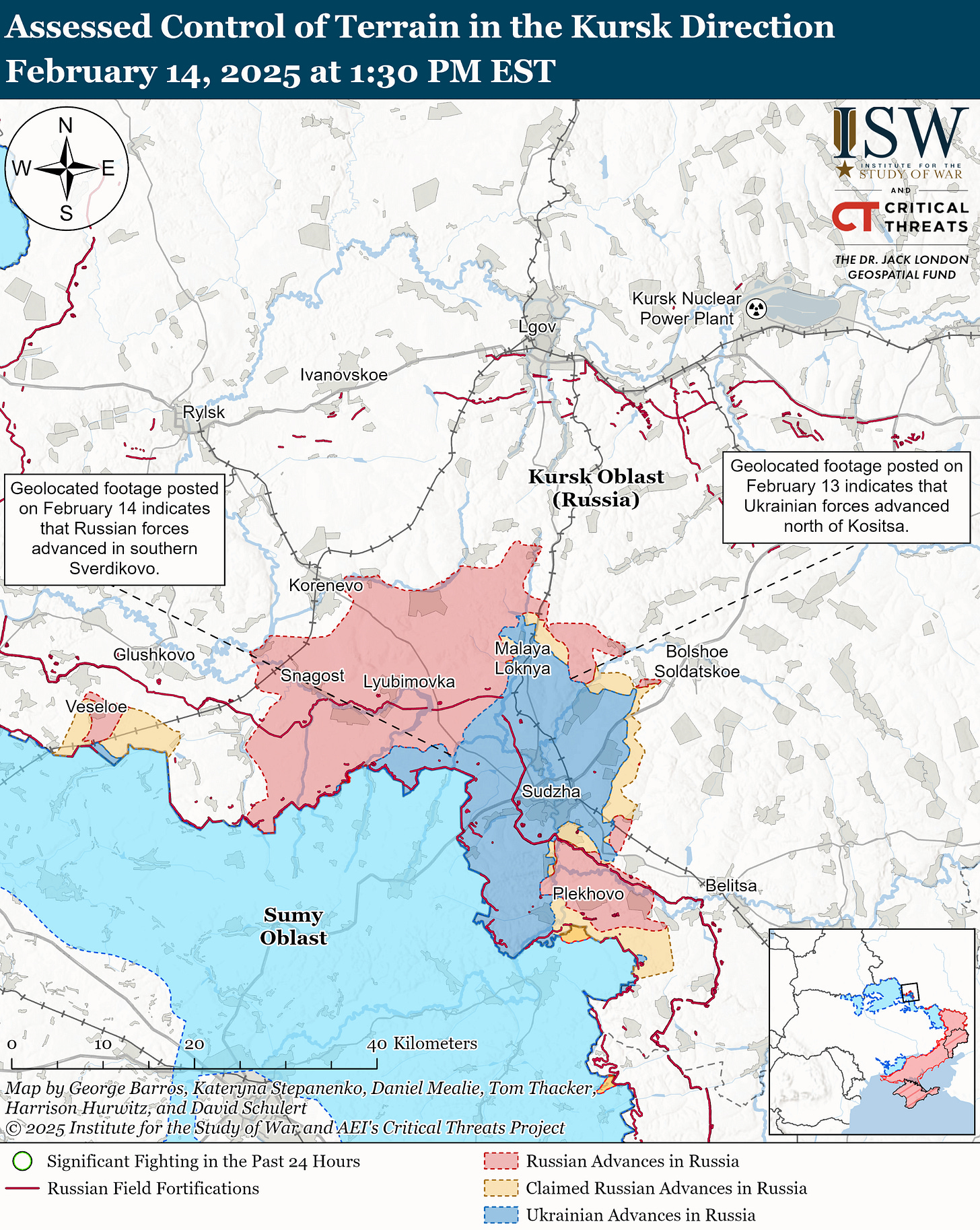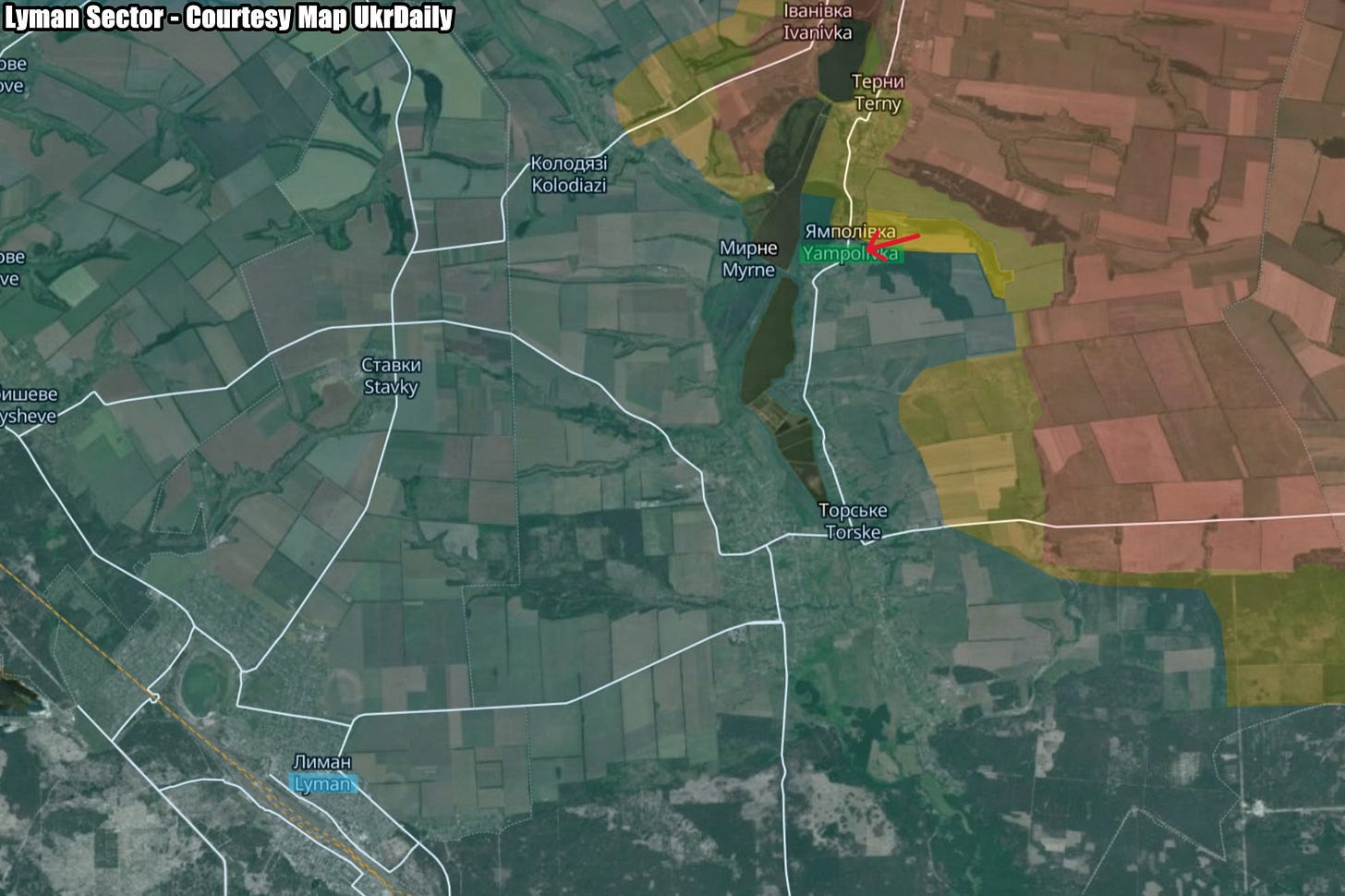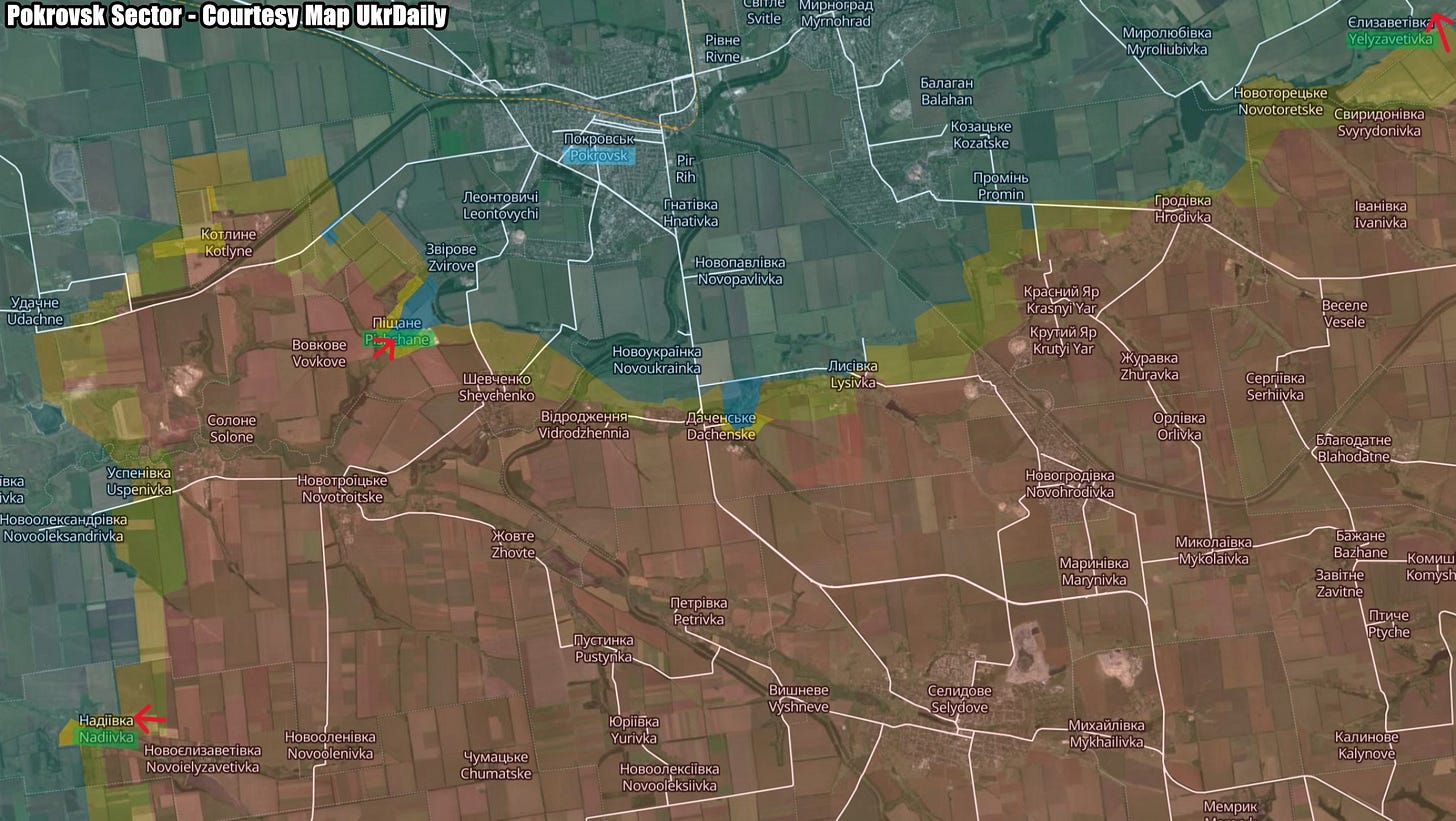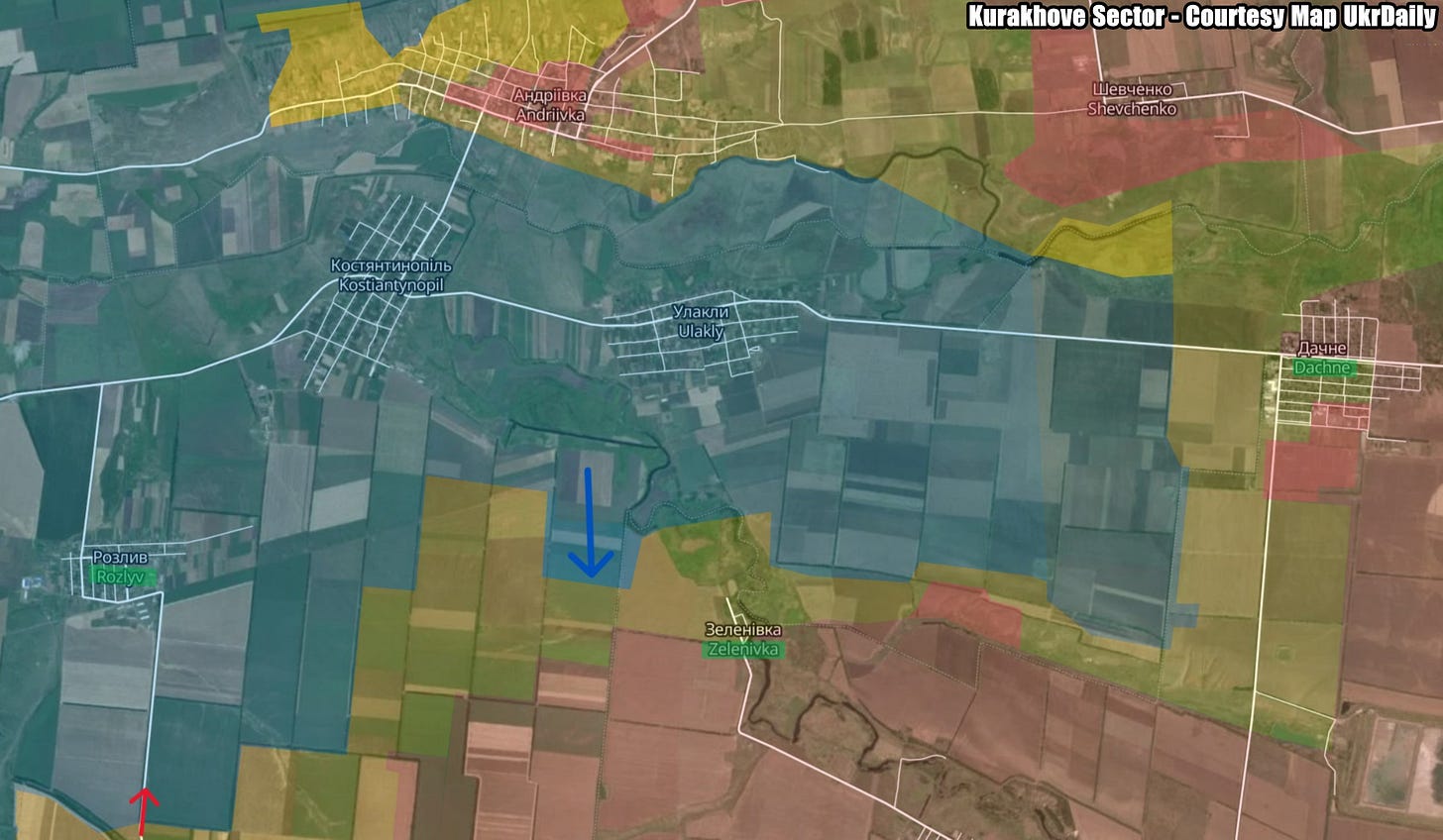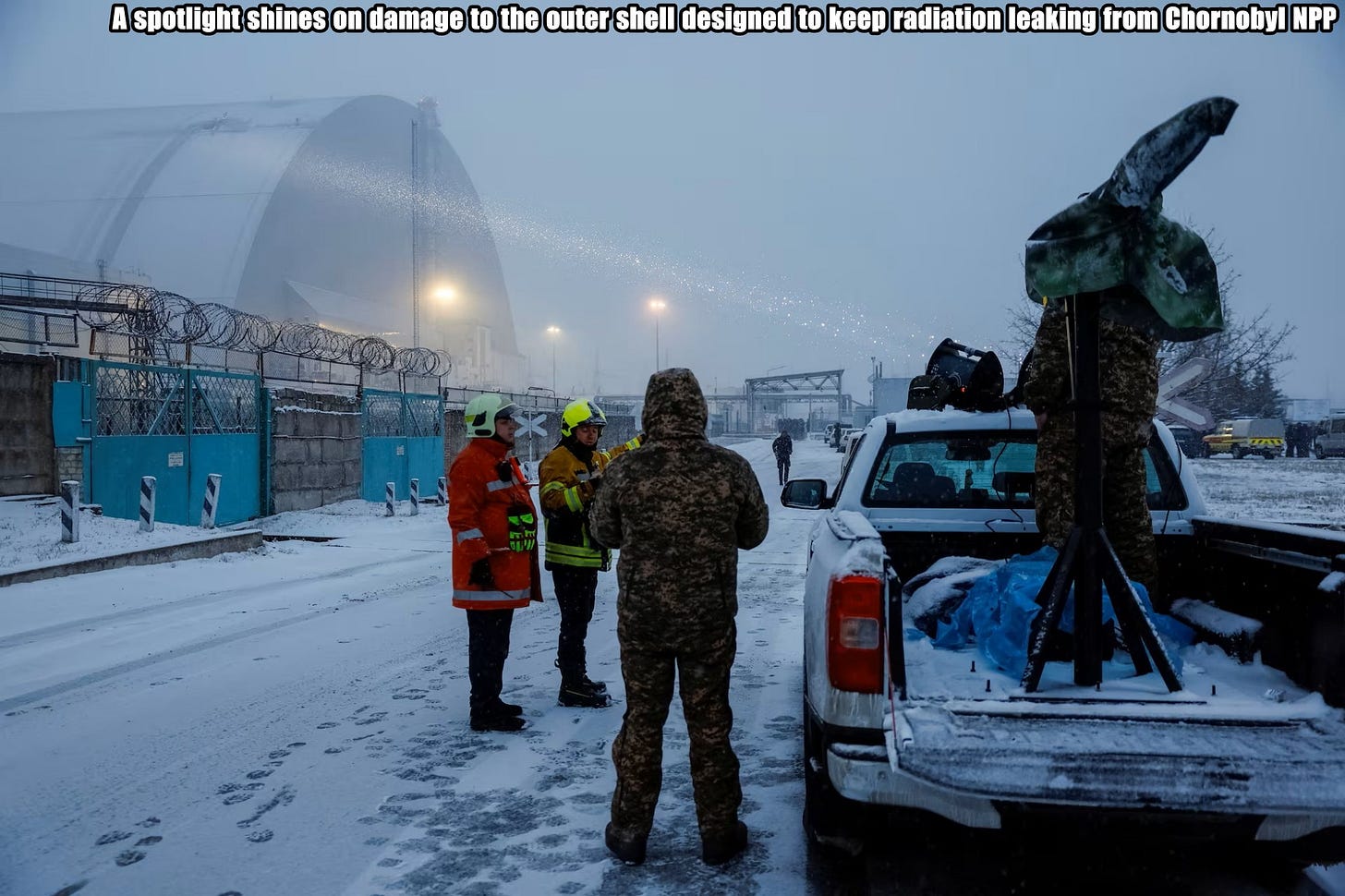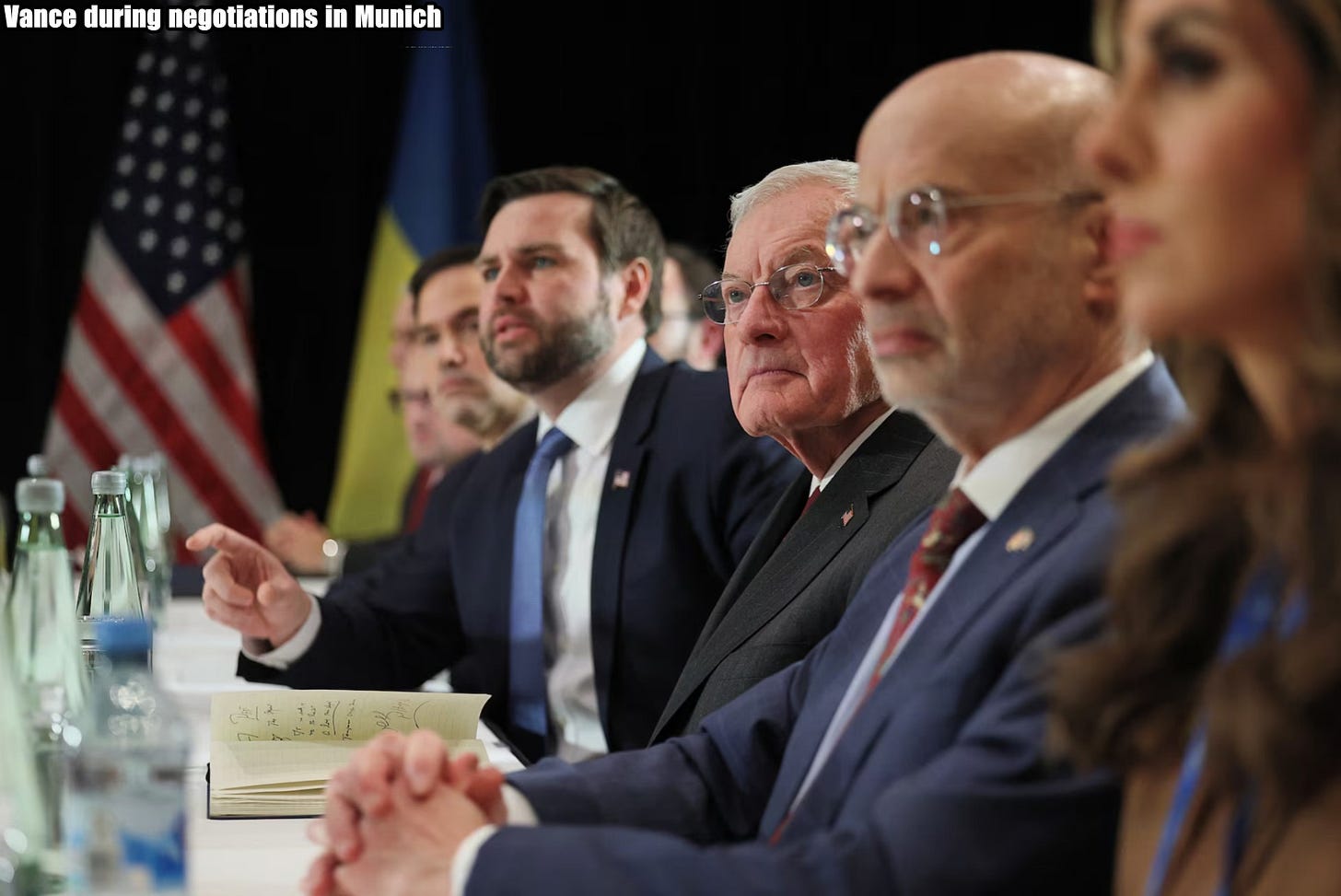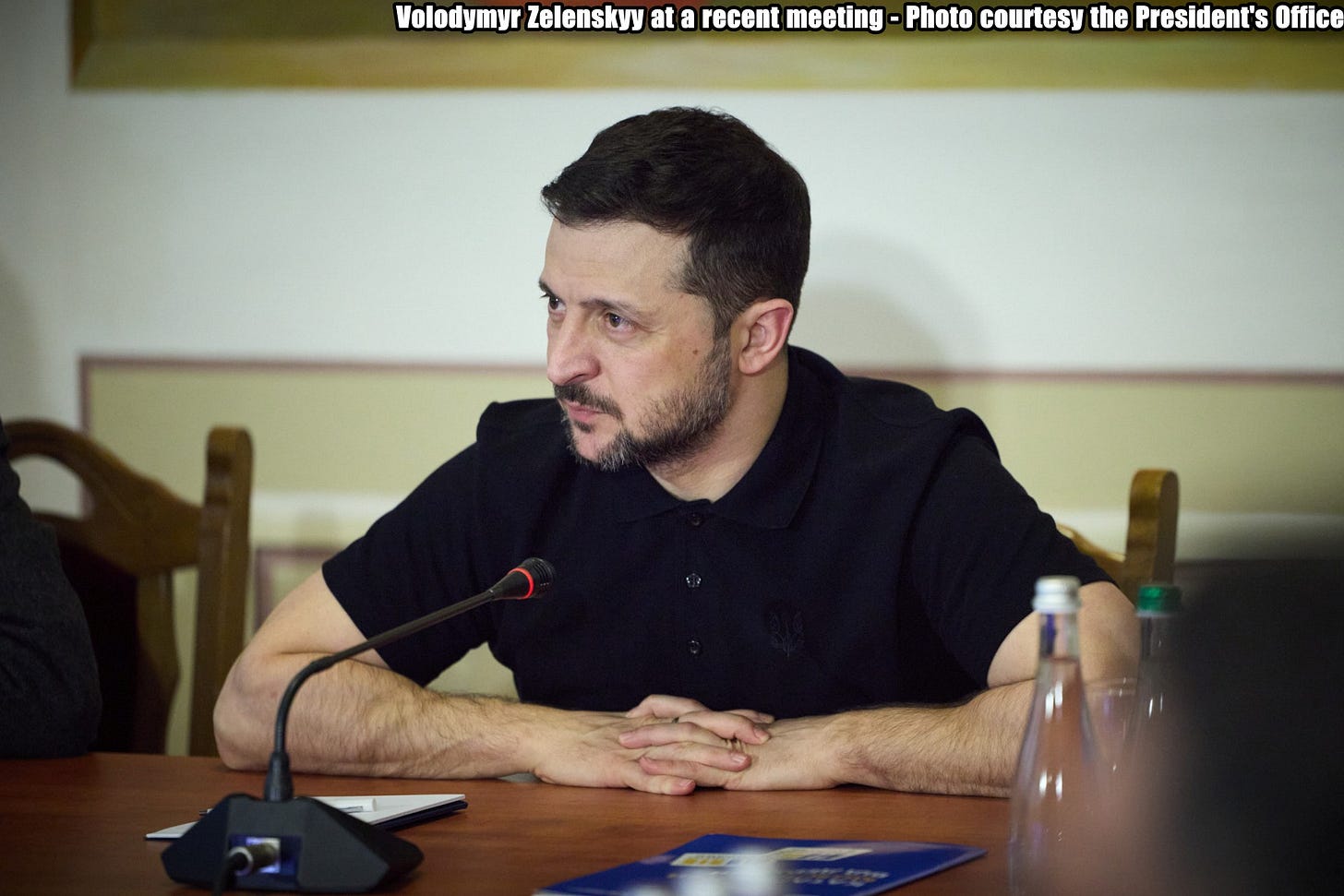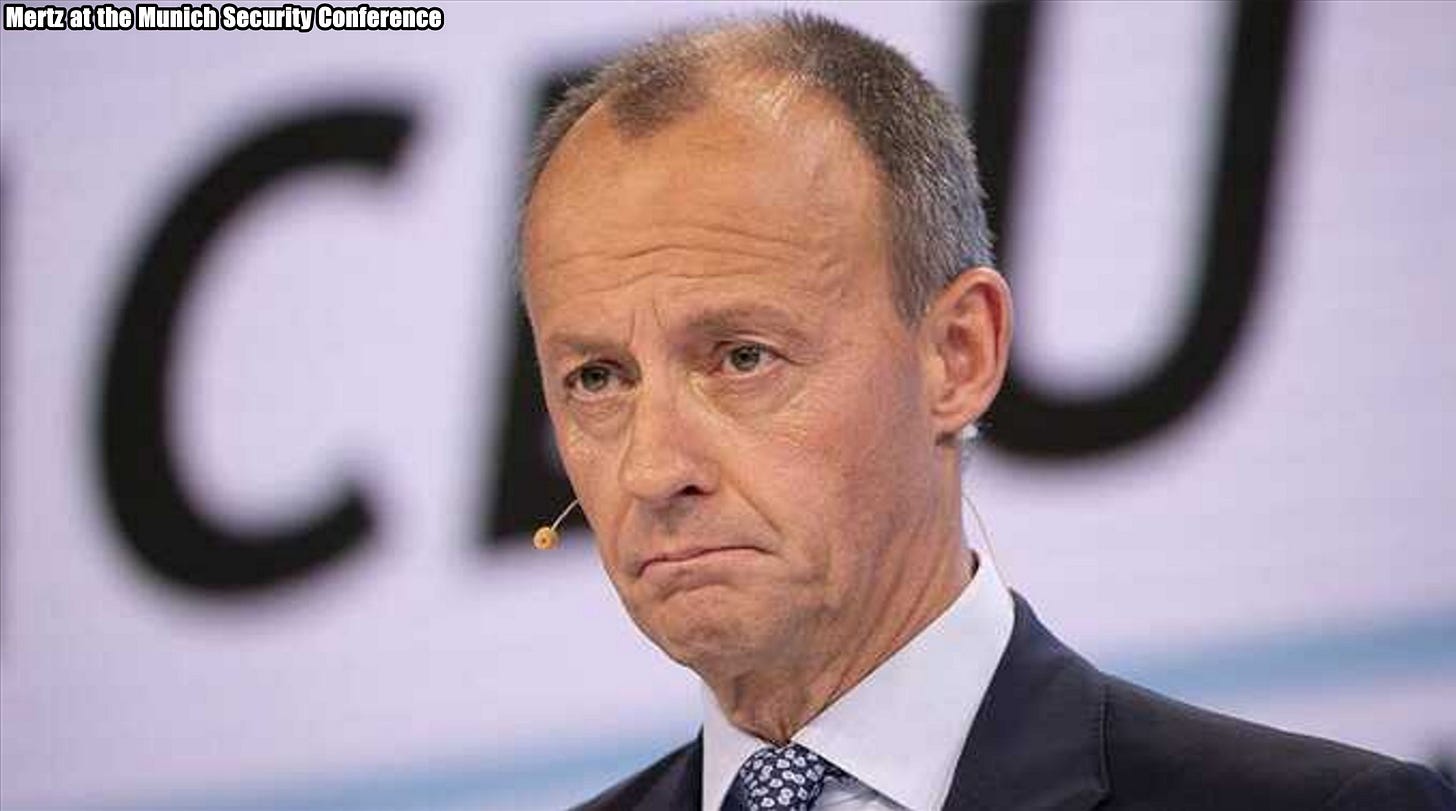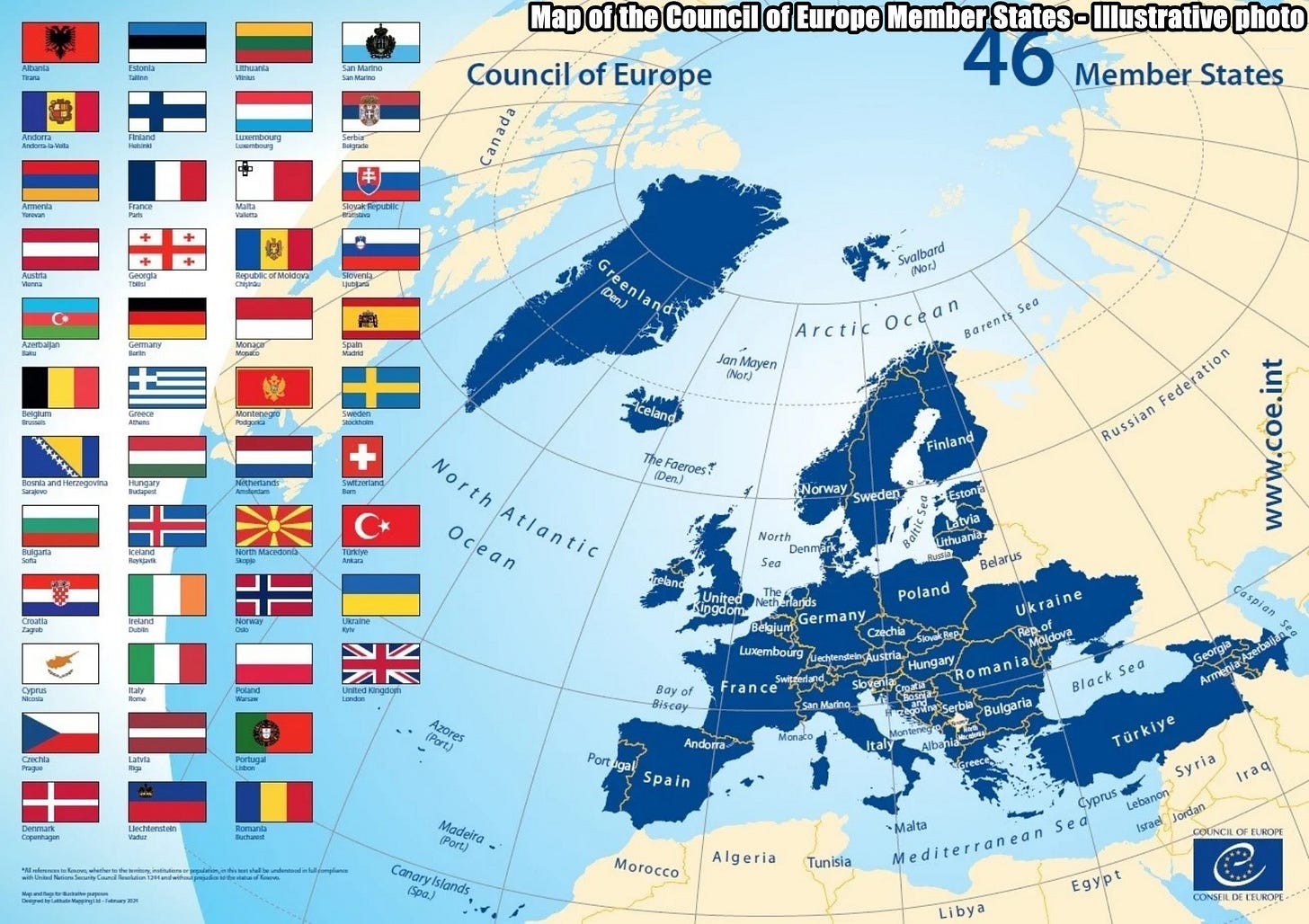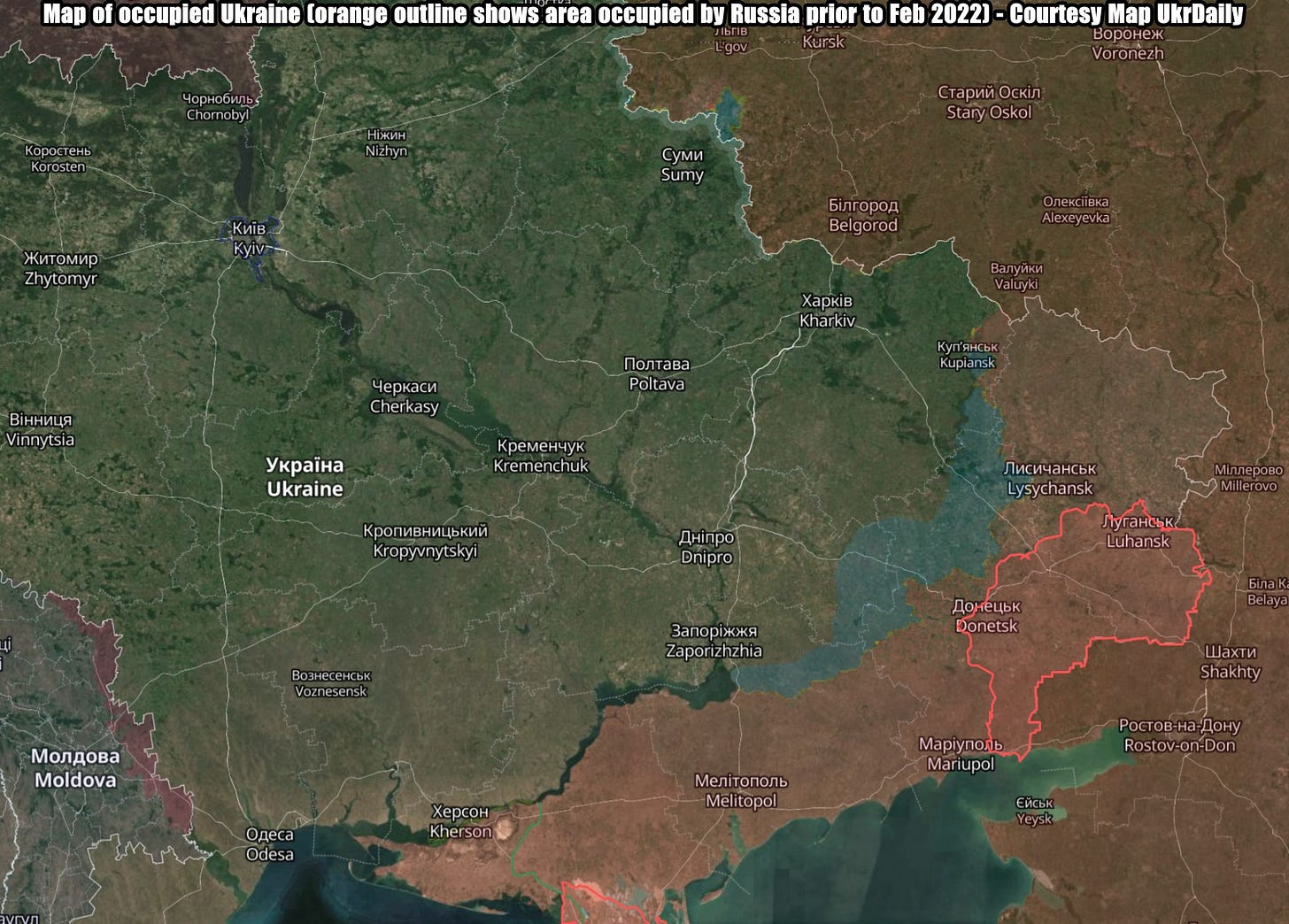Slava Ukraini! In early 2022 I began a Telegram channel aggregating news from a number of sources daily on the war in Ukraine. In June 2023 I began providing a daily draft for the Ukraine War Brief Podcast collecting news from over 70 sources daily, which formed the basis of the script. While the Podcast no longer exists I have continued to make this Brief available for my followers here on Substack for those who wish to keep up with the news from the war.
All the latest news on the Russo-Ukraine War 6 days per week
ALONG THE CONTACT LINE
GSAFU Morning Report
The General Staff of the Armed Forces of Ukraine in its Operational Information update at 08:00 on Feb 15 stated that day 1088 of the full-scale invasion of the Russian Federation against Ukraine had begun.
The situation on the line of combat remains tense in some sectors. Ukrainian defenders continue to actively counteract the Russian aggressor, causing them significant losses in personnel, equipment and technology. Exhausting the enemy along the entire front line and continuing to disrupt the plans of Russian occupiers to advance deeper into the territory of Ukraine.
During the past day, 112 combat engagements took place.
Over the past 24 hours, the enemy carried out missile strikes, 66 air strikes, used 2,436 drones and fired approximately 5,809 artillery shells across the positions of Ukrainian forces and civilians.
Air Force Daily Report
33 ENEMY UAVS SHOT DOWN, 37 DRONES FAILED TO REACH THEIR TARGETS (LOCATIONALLY LOST)
➖➖➖➖➖➖➖➖➖
On the night of February 15, 2025 (from 8:30 p.m. on February 14), the enemy attacked with 70 Shahed-type strike UAVs and simulator drones of various types from the directions: Orel, Millerovo, Primorsko-Akhtarsk - Russia, Chauda - Crimea.
The air attack was repelled by electronic warfare units and mobile fire groups of the Air Force and Defense Forces of Ukraine.
As of 09:00, the shooting down of 33 Shahed attack UAVs and drones of other types in Mykolaiv, Kharkiv, Poltava, Dnipropetrovsk, Zaporizhia and Donetsk regions was confirmed.
37 enemy drones-simulators - lost in location (without negative consequences).
Combat Operations in the Kursk Sector, Russian Federation
The Institute for the Study of War (ISW), a US based think tank, in its Feb 14 Russian Offensive Campaign Assessment reported that Ukrainian and Russian forces recently advanced in Kursk Oblast on Feb 14. Russian milbloggers claimed on Feb 14 that Russian forces repelled a Ukrainian counterattack south of Sudzha near Kurilovka. A Russian milblogger claimed that Russian forces are attacking between Cherkasskaya Konopelka and Kolmakov (north of Cherkasskaya Konopelka) and that unspecified Russian VDV (airborne) units are attempting to recapture Sverdlikovo.
Geolocated footage published on Feb 13 indicates that Ukrainian forces recently advanced in a forested area north of Kositsa (northeast of Sudzha).
Geolocated footage published on 14 indicates that Russian forces recently advanced in the southern outskirts of Sverdlikovo (west of Sudzha).
The Khortytsia operational-strategic group
(Responsible for the northeastern part of Ukraine. )
Kharkiv Sector: Russian forces recently advanced northeast of Kharkiv City.
Footage published on Feb 9 and geolocated on Feb 13 indicates that Russian forces recently marginally advanced along Shchorsa Street in eastern Vovchansk (northeast of Kharkiv City).
Lyman Sector: Russian forces recently advanced northeast of Lyman. Russian forces continued attacks northeast of Lyman near Novosadove, Kolodyazi, Yampolivka, and Novolyubivka on Feb 13 and 14.
Geolocated footage published on February 14 indicates that Russian forces recently advanced in northern Yampolivka. A Russian milblogger claimed that elements of the Russian 37th Motorized Rifle Regiment (67th Motorized Rifle Division, 25th CAA, Central Military District [CMD]) are participating in Russian advances near Yampolivka.
The Tavria operational-strategic group
(Responsible for the central-eastern and southeastern part of Ukraine.)
Pokrovsk Sector : Russian forces recently advanced in the Pokrovsk direction. Russian forces continued attacking east of Pokrovsk near Zelene Pole, Vodyane Druhe, Tarasivka, Yelyzavetivka, Malynivka, and Promin; southeast of Pokrovsk near Lysivka; south of Pokrovsk near Zvirove, Novoukrainka, and Pishchane; and southwest of Pokrovsk near Udachne, Nadiivka, Bohdanivka, Zaporizhzhia, Preobrazhenka, and Uspenivka on Feb 13 and 14. A Russian milblogger claimed that Ukrainian forces counterattacked near Pishchane.
Geolocated footage published on Feb 14 indicates that Russian forces recently marginally advanced north of Yelyzavetivka, within central Pishchane, and northeast of Nadiivka.
Kurakhove Sector: Ukrainian and Russian forces recently advanced in the Kurakhove direction. Russian forces continued attacking west of Kurakhove near Dachne and Kostyantynopil; southwest of Kurakhove near Zelenivka; and northwest of Kurakhove near Shevchenko and Andriivka on Feb 13 and 14.
The Russian MoD claimed on Feb 14 that elements of the 150th Motorized Rifle Division (8th CAA, SMD) seized Dachne, but ISW assessed that Russian forces seized the settlement as of February 6.
Geolocated footage published on Feb 14 indicates that Ukrainian forces recently advanced northeast of Zelenivka.
Geolocated footage published on Feb 13 indicates that Russian forces recently advanced along the C-050450 highway south of Rozlyv (west of Kurakhove).
The Odesa operational-strategic group
(Responsible for Kherson, Qırım, (also known as Crimea) and the Black Sea.)
There have been no major changes to the combat environment since our last report.
TEMPORARILY OCCUPIED TERRITORIES
Nothing major to report.
THE HOME FRONT
Russian drone damages Chornobyl plant's radiation shield.
Ukrainian President Volodymyr Zelenskyy said on Friday that a Russian drone had caused significant damage to the radiation containment shelter at the disused Chornobyl nuclear power plant overnight. Reuters reports.
Zelenskiy and the U.N.'s atomic energy watchdog both said that radiation levels remained normal after the incident, which came as top U.S., Ukrainian and European officials gathered at the Munich Security Conference to discuss the war in Ukraine
The Chornobyl station's chief engineer, speaking to reporters at the site, said a drone had exploded inside and damaged the structure meant to keep radiation from spreading.
Maria Zakharova, spokeswoman for the Russian Foreign Ministry, accused Zelenskyy of orchestrating a drone attack to coincide with the Munich event as part of a lobbying effort to secure more weapons and money from the West.
Chornobyl was the site of the world's worst civil nuclear catastrophe when one of its four reactors exploded in 1986. That reactor is now enclosed by a shelter to contain the lingering radiation.
Chornobyl's last working reactor shut in 2000. Russia occupied the plant and the surrounding area for more than a month during its push to take the Ukrainian capital Kyiv at the beginning of the invasion.
The drone struck the radiation shelter, causing a fire that was then extinguished, Zelenskyy wrote on the Telegram app.
"According to initial assessments, the damage to the shelter is significant," he said.
Chernobyl's chief engineer, Oleksandr Tytarchuk, said emergency crews were working to minimise the aftermath of the incident.
"The barrier which was supposed to prevent the spread of radioactive substances has ceased to function according to its original design," Tytarchuk told reporters at the plant.
He said the drone "hit the outer cover, pierced it, fell into the system and exploded there." Had the explosion occurred 15-20 metres (50-65 feet) further away, he said, "it would have directly hit the old shelter, which is 40 years old".
Ukraine's SBU security service showed pictures of what it said was the drone, which it said had been carrying a high-explosive warhead.
RUSSIAN WORLD
Nothing major to report.
INTERNATIONAL NEWS
Ukraine-US talks in Munich end without agreement on critical minerals deal.
Talks between Ukrainian President Volodymyr Zelenskyy and U.S. Vice President JD Vance ended in Munich on Friday without an announcement of a critical minerals deal that is central to Kyiv's push to win the backing of President Donald Trump. Reuters reports.
Kyiv came back to the U.S. earlier with a revised draft agreement of the deal that could open up its vast resources of key minerals to U.S. investment, amid concerns in Kyiv over a U.S. version that was presented to Ukraine on Wednesday.
"Our teams will continue to work on the document," Zelenskyy wrote on X, adding that he had had a "good meeting" with Vance and that Kyiv was "ready to move towards as quickly as possible towards a real and guaranteed peace".
Two members of the Ukrainian delegation told Reuters that "some details" still needed to be worked out.
It was not immediately clear what the sticking point was, but Ukraine is pressing for robust security guarantees from Europe and the United States that would protect it from Russia in the future if a peace deal is reached.
Zelenskyy set out the contours of the deal in a Reuters interview last week, unfurling a map showing numerous mineral deposits and saying he was offering a mutually beneficial partnership to develop them jointly and not "giving them away".
The minerals in question would include rare earth varieties, as well as titanium, uranium and lithium among others.
Trump, who has not committed to continuing vital military assistance to Ukraine, has said he wants $500 billion in rare earth minerals from Kyiv and that Washington's support needs to be "secured".
Asked earlier if there would be a deal agreed on Friday, Vance had said: "Let's see."
Ukraine was presented with a draft accord drawn up by the United States on Wednesday when Treasury Secretary Scott Bessent travelled to Kyiv. Zelenskyy said Ukraine would study it with a view to reaching an agreement in Munich.
Bessent told Fox Business Network on Friday that the Trump administration's plan to end the war would intertwine Kyiv's economy with the United States, with the U.S. bringing its "best practices" of privatization.
He said: "Part of it starts with intertwining the ... Ukrainian economy more with the U.S., and making sure that U.S. taxpayers receive the return for the money they put in."
Meeting for 90 minutes with a bipartisan group of U.S. senators behind closed doors in Munich, Zelenskyy voiced concern about the U.S. proposal presented on Wednesday, three sources familiar with his presentation said.
He "felt he was being asked unreasonably to sign something he hadn't had a chance to read", one of them said on condition of anonymity. "I don't think he appreciated being given a take-it-or-leave-it thing."
Zelenskyy discussed his own proposal for a mineral deal with the United States, the source said, saying it was drafted to comply with the Ukrainian constitution.
Two other sources characterized the proposal delivered by Bessent as "one-sided", but declined to elaborate.
Democratic Senator Brian Schatz, asked after the meeting if Zelenskyy considered the U.S. proposal one-sided, responded, "I think that's fair to say."
Schatz said that the Trump proposal "needs massaging," but declined to go into detail.
Zelenskyy set out the contours of a deal in a Reuters interview last week, unfurling a map showing numerous mineral deposits and saying he was offering a mutually beneficial partnership to develop them jointly and not "giving them away".
Zelenskyy says Ukraine has 'low chance' of survival without US backing.
Ukraine has little chance of surviving Russia's assault without U.S. support, President Volodymyr Zelenskiy said on Friday after phone calls this week by U.S. President Donald Trump with Zelenskiy and Russian President Vladimir Putin. Reuters reports.
"Probably it will be very, very, very difficult. And of course, in all the difficult situations, you have a chance. But we will have low chance - low chance to survive without support of the United States," Zelenskiy said in an interview on the NBC News program "Meet the Press."
An excerpt was released on Friday from the interview, which will be broadcast on Sunday.
Trump discussed the war on Wednesday in separate calls with Putin and Zelenskiy, in the U.S. president's first big step toward diplomacy in a conflict he has promised to end quickly.
Trump later said he did not think it was practical for Kyiv to join NATO and that it was unlikely Ukraine would get back all its land. Russia, which annexed Crimea in 2014, launched a full-scale invasion of Ukraine in February 2022.
Ukraine demands Russia withdraw from captured territory and says it must receive NATO membership or equivalent security guarantees to prevent Moscow from attacking again.
Zelenskyy said in the interview that Putin wanted to come to the negotiating table not to end the war but to get a ceasefire deal to lift some global sanctions on Russia and allow Moscow's military to regroup.
"This is really what he wants. He wants pause, prepare, train, take off some sanctions, because of ceasefire," Zelenskyy said.
Trump said his call with Putin was a good conversation that lasted over an hour, while the Kremlin said it lasted nearly an hour and a half. Zelenskyy's office said Trump and Zelenskyy spoke for about an hour. Trump said the call "went very well."
Merz says he is ready to give Ukraine Taurus missiles, but with consent of all European partners.
German chancellor candidate and leader of the Christian Democratic Union Friedrich Merz believes that Germany should supply Ukraine with Taurus missiles, but with the consent of all European partners. Merz said this at the Munich Security Conference, Censor.NET reports.
"My personal position and the position of my parliamentary group have always been clear on these cruise missiles. And I would like to reiterate what I said now during the election campaign. We should be ready to supply this (missiles - ed.), but only if we have an agreement with our European partners," he said.
Mertz noted that there are at least two countries that supply long-range missiles to Ukraine - the UK and France. According to him, the partners have to agree on how to coordinate their efforts.
"Both the German parliament, the parliament that exists now, and most likely the future parliament will have a majority. But it will be the decision of the executive branch, not the decision of the parliament. And my personal point of view is that we will supply this equipment to Ukraine, but within the agreed European framework," the politician added.
As a reminder, German Chancellor Olaf Scholz has repeatedly stated that as long as he heads the government, Berlin will not supply Taurus cruise missiles to Ukraine and will not allow German soldiers to participate in the war.
Grumpy Here - The most important part of this statement is that it makes no mention of consulting with the USA, which has been overtly destroying what is left of its international influence since Donald Trump took office.
Europe quietly works on a plan to send troops to Ukraine for post-war security.
Increasingly alarmed that U.S. security priorities lie elsewhere, a group of European countries has been quietly working on a plan to send troops into Ukraine to help enforce any future peace settlement with Russia. A.P. reports.
Britain and France are at the forefront of the effort, though details remain scarce. The countries involved in the discussions are reluctant to tip their hand and give Russian President Vladimir Putin an edge should he agree to negotiate an end to the war he launched three years ago.
What is clear is that Ukraine’s President Volodymyr Zelenskyy needs a guarantee that his country’s security will be assured until peace takes hold. The best protection would be the NATO membership that Ukraine has long been promised, but the U.S. has taken that option off the table.
“I won’t get into the particular capabilities, but I do accept that if there is peace then there needs to be some sort of security guarantee for Ukraine and the U.K. will play its part in that,” British Prime Minister Keir Starmer said in cautious remarks on Thursday.
The Europeans began exploring what kind of force might be needed about a year ago, but the sense of urgency has grown amid concern that U.S. President Donald Trump might go over their heads, and possibly even Ukraine’s, to clinch a deal with Putin.
The talks built on an idea promoted by French President Emmanuel Macron in early 2024. At the time his refusal to rule out putting troops on the ground in Ukraine prompted an outcry, notably from the leaders of Germany and Poland.
Macron appeared isolated on the European stage, but his plan has gained traction since.
Still, much about what the force might look like and who will take part will depend on the terms of any peace settlement, and more.
Italy has constitutional limits on the use of its forces. The Netherlands would need a greenlight from its parliament, as would Germany, whose position could evolve after the Feb. 23 elections usher in a new government. Poland is cautious, given lingering animosities with Ukraine that date from World War II.
The makeup and role of the force will be dictated by the kind of peace deal that’s reached. If Russia and Ukraine can agree terms as the negotiations progress, it’s plausible that fewer security precautions and a smaller force would be needed.
But experts and officials warn that, as things stand, the Europeans must deploy a robust and sizeable contingent, rather than a team of peacekeepers like United Nations “blue helmets.”
“It has to be a real force (so) that the Russians know that if they ever tested it that they would get crushed. And you can be sure that Russia will test it,” Ben Hodges, the former Commanding General of U.S. Army Europe, said last month at a European Policy Centre think tank event.
“They violate every single agreement. So if we send a force in there, they’ve got to have airpower, large land forces, drones, counter-drones, air and missile defense. All of that,” he said. “If they go in there with a bunch of blue helmets and rifles, they will get crushed.”
There also needs to be training of Ukrainian soldiers and investment in Ukraine’s defense industry, Latvia Defense Minister Andris Sprūds told the AP.
The nature of the peace deal will determine the size and location of the European contingent. Zelenskyy has insisted on at least 100,000 to 150,000 troops. Media reports have speculated about a 30,000-40,000 strong force. Diplomats and officials have not confirmed either figure.
Ukraine also wants air support, not just boots on the ground.
What is clear is that the Europeans would struggle to muster a large-scale force, and certainly could not do it quickly.
In an interview on Friday with the Financial Times, Macron said that the idea of deploying a huge force is “far-fetched.”
“We have to do things that are appropriate, realistic, well thought, measured and negotiated,” he said.
U.S. Defense Secretary Pete Hegseth insisted this week on “robust international oversight of the line of contact,” a reference to the roughly 1,000-kilometer (600-mile) long front line. The Europeans are reluctant as that would require too many troops.
Nearly all agree that some kind of “American backstop” is essential. European armed forces have long relied on superior U.S. logistics, air transport and other military capabilities.
At NATO headquarters on Wednesday, Hegseth began describing the terms under which the U.S. might agree to a force that would help provide Ukraine with the “robust security guarantees to ensure that the war will not begin again.”
“Any security guarantee must be backed by capable European and non-European troops,” Hegseth told almost 50 of Ukraine’s Western backers. If they go to Ukraine, he said, “they should be deployed as part of a non-NATO mission.”
Putin has said that he launched the invasion in part due to NATO territory expanding too close to Russia’s borders and is unlikely to accept any operation run by the world’s biggest military organization.
Any European allies taking part would not benefit from NATO’s collective security guarantee if they were attacked, Hegseth said. He underlined that “there will not be U.S. troops deployed to Ukraine.”
He did not reveal what role the U.S. might play.
From Ukraine’s perspective, a Europe-only operation simply would not work. “Any security guarantees are impossible without the Americans,” Ukrainian Foreign Minister Andrii Sybiha warned Thursday.
Russia must withdraw to at least pre-2022 front line, Zelenskyy says.
Russia has to pull back its troops to at least the front line as it was before the full-scale invasion in 2022, President Volodymyr Zelenskyy said on Feb. 15 in an interview with Newsmax. The Kyiv Independent reports.
Zelenskyy's comments come after earlier in the week, U.S. Defense Secretary Pete Hegseth said that Ukraine was unlikely to restore its pre-2014 borders in any negotiations with Moscow on ending its war. Experts and officials in Ukraine and Europe have criticized Hegseth's comments for undermining Ukraine's leverage before peace talks with Russia have even started.
Zelenskyy told Newsmax that U.S. President Donald Trump could end Russia's war if Europe supports his plan.
"I think that he (Trump) needs, very much, the success, and, otherwise, everybody will say that (this) was the line of Biden and this is the line of Trump. I think he needs success, and we need success and trust him. I hope that he will be on our side," Zelenskyy added.
Trump has repeatedly pledged to swiftly end the war in Ukraine although he never presented a plan for achieving that.
On Feb. 12, Trump held separate calls with Russian President Vladimir Putin and Zelensky. Trump called Putin first, saying later that the two leaders agreed that negotiations to end the war in Ukraine will start "immediately."
Zelenskyy stressed that a peace deal "can only be about a plan to end the war," which should be agreed upon between Ukraine and the U.S. president and backed by both sides.
Zelenskyy said he was ready to meet with the Russian president only after a joint plan with Trump and the European Union was developed.
U.S.-Russia Talks 'Obsolete' After Chernobyl Drone Strike – Kallas
The European Union’s top diplomat said that any talks between the United States and Russia were now “obsolete” following a drone strike at Ukraine’s Chernobyl nuclear power plant that Kyiv blamed on Moscow. The Moscow Times reports.
“It clearly shows that [the Russians] don't want peace,” EU foreign policy chief Kaja Kallas told journalists on the sidelines of the Munich Security Conference. “All these other talks have been totally obsolete because of the bombing of the nuclear station, bombing of civilians, bombing of civilian infrastructure.
“What is up to us right now is to decide and discuss how we support Ukraine right now in this endeavor because our values haven't changed, the goals of Russia haven't changed either, so we need to stick to our ground and really see what is at stake here.”
Earlier this week at the NATO defense ministers' meeting in Brussels, Kallas had accused U.S. President Donald Trump of “appeasement” following his conversation with Russia’s Vladimir Putin and stressed that any peace deal must be negotiated with European and Ukrainian involvement.
Trump’s Vice President JD Vance and Ukrainian President Volodymyr Zelensky are expected to meet Friday during the three-day conference in southern Germany. Zelensky told journalists on Friday that he did not believe Washington had a “ready-made plan” to end the war.
Kallas, a former prime minister of Estonia, has long been a vocal supporter of Ukraine. During her premiership, Estonia donated more aid per capita to Ukraine than any other country, at 3.55% of GDP.
She has said Trump was right to criticize Europe for only spending an average of 1.9% of GDP on defense, saying it was “clearly not enough” in comparison to Russia’s 9%.
Kallas told The Moscow Times on Friday that Washington and Europe needed to provide similar messages about supporting Ukraine and ending the war.
“I hope to keep united with our American allies, because it's Iran, Russia, also North Korea, but more covertly China teaming up against us, so we need to stick to our ground,” she said.
MILITARY & TECH
Nothing major to report.
That’s it for today’s Brief folks if you would like to keep up with events in Ukraine daily please consider subscribing, it’s free!


